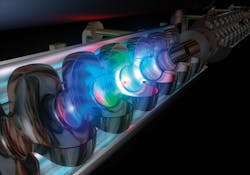DARPA extends deadline to investigate future muon particle beams for electromagnetic weapons and sensors
ARLINGTON, Va. – U.S. military researchers have given industry an extra three weeks to decide on bidding on a project to develop enabling technologies for future atomic charged particle beams potentially able to destroy enemy electronics and weapons, as well as to detect submarines in the ocean or nuclear weapons hidden in caves.
Officials of the U.S. Defense Advanced Research Projects Agency (DARPA) in Arlington, Va., have extended the bidding deadline until 31 Oct. 2022 for the broad agency announcement (HR001122S0049) for the Muons for Science and Security (MuS2) project. The previous deadline was 11 Oct. 2022.
Muons are atomic particles similar to electrons, but are 207 times heavier. A muon beam has the potential to help create new kinds of electromagnetic weapons, sensors to penetrate mountains and oceans, and help study the nature of matter and the universe.
The DARPA MuS2 project seeks to create a source for a muon beam strong enough to support demonstrations of national security and scientific applications.
DARPA researchers are asking industry investigate the generation of directional muon beams with energies of 10 to 100 giga-electron volts, and produce 106 to 108 muons while showing a clear path to a practical design for transportable military weapons and sensors.
No practical active sources of muons exist today because of the high energies necessary to create them, researchers say. Muons are charged elementary particles about 200 times heavier than electrons, with a mean lifetime of 2.2 microseconds.
Muons form naturally through giga-electron volt cosmic-ray interactions in the upper atmosphere or synthetically at high-energy physics experimental facilities such as Fermilab and the European Organization for Nuclear Research.
Muons penetrate easily, with ranges of tens to hundreds of meters through water or rock; are highly detectable; sensitive to density variations, and generally impart low doses to people and objects.
Applications to date have included finding hidden chambers in Egyptian pyramids; predicting volcano eruptions; detecting contraband in cargo; and inspecting nuclear reactors.
Unfortunately, cosmic sources of muons are very dim, with only about one passing through the area of a human hand per second, which then requires integration times of hours to months, depending on the application. Muons are also produced at a wide range of angles in the atmosphere, which influences their resolving power for imaging applications.
Developing a path to a transportable source of high-intensity muons could enable applications like screening large objects or searching buildings for nuclear materials. Muon imaging could also could provide a capability for tunnel or chamber detection because muons can penetrate 65 to 600 feet of heavy soil. In addition, a muon source could provide a stepping stone to muon-catalyzed low-temperature fusion.
Related: High-energy laser weapons ready for the front lines
The MuS2 project seeks to develop enabling technologies sufficient for a future prototype muon beam generator with a strength of 10 to 100 giga-electron volts, a weight of no more than about 16 tons, and a size able to fit inside a 40-foot intermodal shipping container. The actual prototype muon beam generator is not part of this project.
MuS2 is a four-year program with two 24-month phases for experiments, simulations, and system studies. The firsts phase will examine the feasibility of muon production, including modeling and preliminary experimental work.
Teams will demonstrate accelerating electrons to 10 giga-electron volts or greater, and explore designs for an advanced laser driver that would enable a transportable system capable of producing 100 giga-electron-volt muons and intensities 108 muons per second.
The second phase will emphasize applied research leading to proof-of-concept studies at high energy. At the end of phase 2, teams will demonstrate accelerating electrons to 100 giga-electron volts or greater and produce a minimum of 106 muons per experiment.
There will be two go/no-go decisions, the first at about one year into the first phase, and the second before a possible move to phase 2.
Companies interested should upload full proposals by 31 Oct. 2022 online to the DARPA BAA website at https://baa.darpa.mil. Email questions or concerns to Mark Wrobel, the DARPA MuS2 program manager at [email protected]. More information is online at https://sam.gov/opp/8f2e6672f9714f318bb7901ef32684d3/view.
About the Author
John Keller
Editor-in-Chief
John Keller is the Editor-in-Chief, Military & Aerospace Electronics Magazine--provides extensive coverage and analysis of enabling electronics and optoelectronic technologies in military, space and commercial aviation applications. John has been a member of the Military & Aerospace Electronics staff since 1989 and chief editor since 1995.
